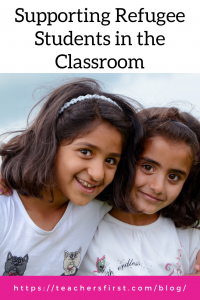June 20th is World Refugee Day, established by the UN to honor the courage and perseverance of people forced to flee their home country. Among these refugees are school-aged children entering communities largely unknown to them. With that influx, public school systems have taken on the responsibility of welcoming and supporting these students.
Supporting refugee students is not a simple task, especially considering the increased pressure on teachers to ensure their students’ academic success. But, it can’t only be about getting refugee students up to academic standards. Boston area high school teacher Jessica Lander says it best: “When it comes to educating refugee students, it’s not enough to just teach them. Schools also need to help them feel welcome — and supported.”
As we know, when students don’t have a sense of belonging in a classroom, learning is nearly impossible. That’s why it is just as important to consider strategies and activities that support refugee students’ emotional well-being as their academic growth.
Larry Ferlazzo, Education Week contributor, shares that “…most importantly, teach through a “trauma-informed” lens. Elements of this kind of teaching can include emphasizing relationship-building activities…and establishing and implementing predictable classroom routines.” That’s why having ongoing community-building activities, such as morning meetings or restorative circles, can be so powerful, especially when refugee students join your class in the middle of a school year. Morning meetings and community circles provide safe spaces for refugee students to share more about themselves and their backgrounds. This is not to say that we should be putting refugee students on the spot and forcing them to share their experiences, but rather providing a space where they feel they can if they want to share. I also recognize that it may feel jarring to have students who have experienced trauma share it with the entire class. However, if students raise topics that are too complex for other students to process, you can offer a private space for them to share more and find additional support.
You can also use resources like Reading Treks. These interactive maps document travel and build context around the story, to help students build empathy for and understanding of their refugee classmates’ experiences. For intermediate grade levels and above, I suggest the book, Refugee by Alan Gratz. Lost and Found Cat would work for primary grade levels.
There are also simple considerations that can significantly impact the well-being of your refugee students and families. For example, something as basic as learning how to pronounce students’ names correctly can show them that you care. You can take this supportive gesture even further by creating a Flipgrid where students can record how to pronounce their names and share what it means or its background. A benefit of using Flipgrid (reviewed here) is having the recordings available to all students in the class, allowing everyone to learn proper pronunciations.
Learning how to greet students in their native language is another small but powerful thing you can do for them. Posting a world map in your room and inviting students to show where they come from with sticky notes or pins can make a classroom inclusive. Better yet, you could create a public Google map (reviewed here) where students can add their home countries and information about them for your classroom community to explore. Need help creating a Google Map? Check out this OK2Ask session to learn more.
Also, consider how you can leverage the Funds of Knowledge that your refugee students bring to your classroom. In her Harvard Ed Magazine article, Jessica Lander shares how she elevated the culture of her refugee students. At the end of an immigration unit, Jessica asked students to share a piece of their migration story, told through a favorite family recipe. She took all of these migration-story recipes and published a classroom cookbook. This lesson could be adapted to any grade level. To share with families, you can easily create an online classroom cookbook (or any other book compilation) with WriteReader (reviewed here).
We would love to hear your ideas and strategies for supporting refugee students. What other opportunities help bring your students’ cultures into the space? Share your thoughts in the comments below!


